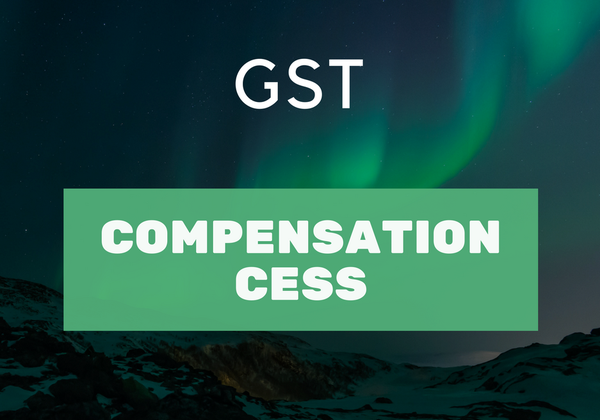Description

Disclaimer: Copyright infringement not intended.
Context
- Outstanding Goods and Services Tax (GST) Compensation dues to States now amount to Rs 35,266 crore, the Finance Ministry told Parliament.
GST Compensation and its Background
- The introduction of the Goods & Services Tax (GST) required States and Union Territories (with Legislature) to subsume their sovereignty in a GST Council.
- States had to cede almost all their powers to impose local-level indirect taxes and agreeing to let the prevailing multiplicity of imposts be subsumed under the GST.
- While the States would receive the SGST (State GST) component of the GST, and a share of the IGST (Integrated GST),
there will be loss in total revenue of a state on account of migration from Value Added Tax/Sales Tax to GST.
- Thus, it was agreed that revenue shortfalls arising from the transition to the new indirect taxes regime would be made good from a pooled GST Compensation Fund for a period of five years.
- GST law prescribes that the financial year 2015-16 shall be taken as the base year for the purpose of calculating compensation and States were assured of a 14 per cent growth in revenues every year.
How is it funded?
- In order to mobilize resources for compensation, a cess is being levied on such goods, as recommended by the Goods and Services Tax Council, over and above the GST on that item.It is levied on so-called ‘demerit’ goods. And it is called compensation cess.
- As on date, compensation cess is levied on products such as pan masala, tobacco, aerated waters and motor cars apart from coal.
Who pays compensation to whom? When?
- The consumer is required to pay for compensation. It is collected by the Centre which releases it to States.
- The proceeds of the compensation cess is credited to a non-lapsable fund known as the Goods and Services Tax Compensation Fund in the public account.
- All amounts payable to the States as compensation are released bi-monthly, provisionally, from said fund against figures given by the Central accounting authorities.
- Final adjustments are done after receiving audited accounts of the year from the Comptroller and Auditor General of India.
Salient Aspects of GST Cess
- The GST Cess of The Goods and Services Tax (Compensation to State) Act, 2017 provides the manner of ascertaining the amount of compensation payable to the state during the transition period of 5 years by the Central Government on account of revenue loss attributable to levy goods and services tax.
- To ascertain the Base year.
- To identify the revenue for the base year
- Computation of compensation and release of compensation
- Projected revenue.
For how long will it be paid?
- According to the law, it will be paid for five years from the date GST came into effect; i.e. till June, 2022.
GST Cess Applicability
- GST Cess would apply to both the supply of goods or services that the Central Government has notified. Also, inter and intra state supplies of goods and services would attract GST cess. Under GST, all taxable persons, except registered taxpayers under GST composition scheme, are expected to collect and remit GST cess.
The following goods will attract GST Cess
- Pan Masala
- Unmanufactured tobacco (with/without lime tube) – featuring a brand name
- Branded Tobacco refuse
- Cheroots and Cigar
- Cigarillos
- Cigarettes containing tobacco excluding filter cigarettes, of length not more than 65 mm
- Cigarettes containing tobacco apart from filter cigarettes, of length more than 65 mm and up to 75 mm
- Branded ‘Hookah’ or ‘gudaku’ tobacco
- Chewing tobacco (w/o or with lime tube)
- Pan masala (Gutkha) containing tobacco
- Coal, ovoids, briquettes, and similar solid fuels manufactured from lignite, coal, whether or not agglomerated, excluding jet, peat (including peat litter), whether or not agglomerated
- Aerated waters
- Motor cars and other motor vehicles (including station wagons and racing cars) principally designed for the transport of persons (excluding motor vehicles for the transport of 10 or more persons, including the driver)
- Petrol, liquefied petroleum gas (LPG) or compressed natural gas (CNG) driven motor vehicles of engine capacity not exceeding 1200cc and of length not exceeding 4000 mm.
- Diesel driven motor vehicles of engine capacity not exceeding 1500cc and of length not exceeding 4000 mm.
- Motor vehicles of engine capacity not exceeding 1500 cc
- Motor vehicles of engine capacity over 1500 cc, popularly known as Sports Utility Vehicles (SUVs) including utility vehicles.
Why are States demanding an extension of the compensation?
- States say that pandemic has affected revenue collection.
- At the same time, their expenses have gone up and they expect higher deficit as revenue growth is low.
- Considering all these, States are seeking an extension of compensation for five more years. Any decision, in this regard, has to be taken by GST Council.
Back-to-back loan arrangement for Compensation
- The economic impact of the pandemic led to higher compensation requirement due to lower GST collection and, at the same time, lower collection of GST compensation cess.
- Accordingly, in FY21, the Centre had borrowed Rs 1.1-lakh crore under a special window and passed it on to the States as back-to-back loan.
- This was meant to help States meet the resource gap due to short-release of compensation on account of inadequate balance in the compensation fund.
- The Centre says it is committed to releasing full GST Compensation to the States/UTs as per law for the transition period by extending the levy of compensation cess beyond 5 years to meet the GST revenue shortfall as well as servicing the loan borrowed through a special window scheme.
Read: https://www.iasgyan.in/daily-current-affairs/goods-and-services-tax-gst
https://epaper.thehindu.com/Home/ShareArticle?OrgId=GSGA22NIO.1&imageview=0
1.png)














